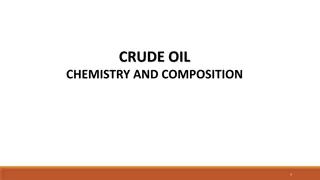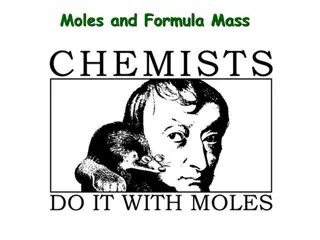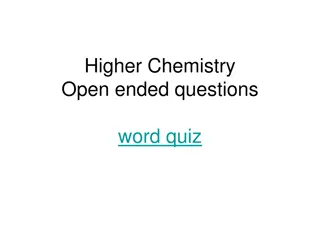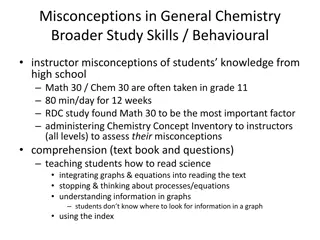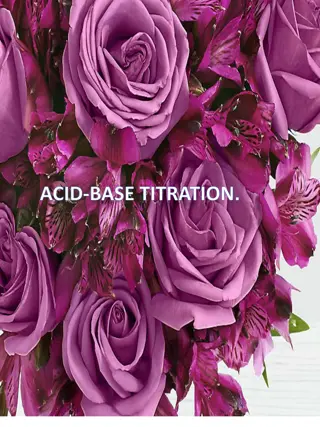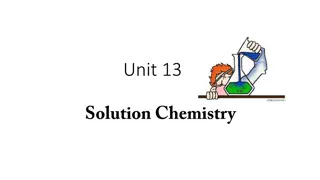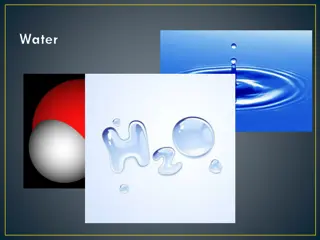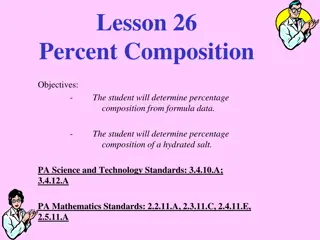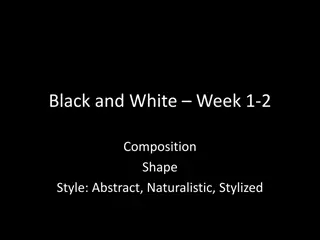Understanding Solution Composition in Chemistry
Exploring the properties of solutions, this content delves into measuring solution composition using techniques like molarity, mass percent, and mole fraction. Through examples, it explains how to calculate the weight percent of solutes in solutions, offering a comprehensive guide on understanding essential concepts in chemistry.
Download Presentation

Please find below an Image/Link to download the presentation.
The content on the website is provided AS IS for your information and personal use only. It may not be sold, licensed, or shared on other websites without obtaining consent from the author. Download presentation by click this link. If you encounter any issues during the download, it is possible that the publisher has removed the file from their server.
E N D
Presentation Transcript
Chapter 11 Properties of Solutions DE Chemistry Dr. Walker
Solutions In a solution, the excess material is the solvent, the smaller amount is the solute
Measuring Solution Composition Molarity is most common, covered previously in Chapter 4
Measuring Solution Composition Mass Percent
Mass Percent Example What is the weight percent of ethanol in a solution made by dissolving 5.3 g of ethanol (C2H5OH) in 85.0 mL of water?
Mass Percent Example What is the weight percent of ethanol in a solution made by dissolving 5.3 g of ethanol (C2H5OH) in 85.0 mL of water? Density of water = 1.0 g/mL, therefore 85 mL of water = 85 g Mass of solute/mass of solution x 100 = mass % 5.3 g ethanol/(5.3 g ethanol + 85.0 g water) = 5.9%
Measuring Solution Composition Mole Fraction
Mole Fraction Example What is the weight percent of ethanol in a solution made by dissolving 5.30 g of ethanol (C2H5OH) in 85.0 mL of water? Note: If the density of water is 1.0 g/mL, 85 mL = 85 g
Mole Fraction Example What is the weight percent of ethanol in a solution made by dissolving 5.30 g of ethanol (C2H5OH) in 85.0 mL of water? Note: If the density of water is 1.0 g/mL, 85 mL = 85 g Calculate moles of ethanol: 5.30 g C2H5OH 1 mole C2H5OH = 0.115 moles C2H5OH 46.08 g C2H5OH
Mole Fraction Example What is the weight percent of ethanol in a solution made by dissolving 5.30 g of ethanol (C2H5OH) in 85.0 mL of water? Note: If the density of water is 1.0 g/mL, 85 mL = 85 g Calculate moles of water: 85.0 g H2O 1 mole H2O 18.02 g H2O = 4.72 moles H2O
Mole Fraction Example What is the weight percent of ethanol in a solution made by dissolving 5.30 g of ethanol (C2H5OH) in 85.0 mL of water? Note: If the density of water is 1.0 g/mL, 85 mL = 85 g Mole Fraction of ethanol 0.115 moles C2H5OH = 0.024 0.115 moles C2H5OH + 4.72 moles H2O Mole Fraction of Water 4.72 moles H2O = 0.976 0.115 moles C2H5OH + 4.72 moles H2O
Measuring Solution Composition Molality
Example What is the weight percent of ethanol in a solution made by dissolving 5.30 g of ethanol (C2H5OH) in 85.0 mL of water? Note: If the density of water is 1.0 g/mL, 85 mL = 85 g
Example What is the weight percent of ethanol in a solution made by dissolving 5.30 g of ethanol (C2H5OH) in 85.0 mL of water? Note: If the density of water is 1.0 g/mL, 85 mL = 85 g Molality = moles solute/kg solvent 5.30 g C2H5OH 1 mole C2H5OH = 0.115 moles C2H5OH 46.08 g C2H5OH
Measuring Solution Composition Normality Equivalents of acids and bases Mass that donates or accepts a mole of protons (usually a subscript of H+ or OH-) Equivalents of oxidizing and reducing agents Mass that provides or accepts a mole of electrons (usually a subscript)
Normality Find molarity first Normality = Molarity x number of acidic protons 1.5 M HCl = 1.5 N HCl (1 acidic proton) 1.5 M H2SO4 = 3.0 N H2SO4 (2 acidic protons) 1.5 M H3PO4 = 4.5 N H3PO4 (3 acidic protons)
Energy of Solution Formation Like Dissolves Like Polar molecules and ionic compounds tend to dissolve in polar solvents Nonpolar molecules dissolve in nonpolar compounds Water - polar Butane - nonpolar
Heat of Solution The Heat of Solution is the amount of heat energy absorbed (endothermic) or released (exothermic) when a specific amount of solute dissolves in a solvent. Substance Heat of Solution (kJ/mol) -44.51 +25.69 +34.89 -74.84 NaOH NH4NO3 KNO3 HCl
Steps in Solution Formation H1 Step 1 - Expanding the solute Separating the solute into individual components usually endothermic
Steps in Solution Formation H2 Step 2 - Expanding the solvent Overcoming intermolecular forces of the solvent molecules usually endothermic
Steps in Solution Formation H3 Step 3 - Interaction of solute and solvent to form the solution usually exothermic
Enthalpy of Solution May be positive or negative Negative is favorable (exothermic) Positive values are endothermic, does not dissolve spontaneously Solution formation increases entropy (favorable)
Factors Affecting Solubility Structure Effects Polar (hydrophilic) dissolves in polar Water soluble vitamins Nonpolar (hydrophobic) in nonpolar Fat soluble vitamins
Pressure Effects Henrys Law The concentration of a dissolved gas in a solution is directly proportional to the pressure of the gas above the solution kP C= Applies most accurately for dilute solutions of gases that do not dissociate or react with the solvent Yes CO2, N2, O2 No HCl, HI remember, these dissociate in solution!
Henrys Law Example Unopened bottle: C = kP C = (3.1 x 10-2 mol/L . Atm)(5.0 atm) = 0.16 mol/L Opened bottle: C = kP C = (3.1 x 10-2 mol/L . Atm)(4.0 x 10-4 atm) = 1.2 x 10-5 mol/L
Solubility Temperature Effects Solids Increases in temperature always cause dissolving to occur more rapidly Increases in temperature usually increases solubility (the amount that can be dissolved) Gases Solubility of gases always decreases with increasing temperatures
Vapor Pressure Nonvolatile solutes Nonvolatile electrolytes lower the vapor pressure of a solute Nonvolatile molecules do not enter the vapor phase Fewer molecules are available to enter the vapor phase Dissociation of ionic compounds has nearly two, three or more times the vapor pressure lowering of nonionic (nonelectrolyte) solutes.
Raoults Law The presence of a nonvolatile solute lowers the vapor pressure of the solvent. P = 0 solvent P solution solvent Psolution = Observed Vapor pressure of the solution solvent= Mole fraction of the solvent P0solvent = Vapor pressure of the pure solvent This should make sense, since you ve learned previously that dissolved Solutes raise boiling points. Lower vapor pressure = higher boiling point
Raoults Law Example 1.5 moles of cherry Kool-Aid are added to a pitcher containing 2 liters of water on a nice day at 25oC. The vapor pressure of water alone is 23.8 mm Hg at 25oC. What is the new vapor pressure of Kool-Aid?
Raoults Law Example 1.5 moles of cherry Kool-Aid are added to a pitcher containing 2 liters of water on a nice day at 25oC. The vapor pressure of water alone is 23.8 mm Hg at 25oC. What is the new vapor pressure of Kool-Aid? Usually, you must solve for the mole fraction of the solvent first: Mole Fraction of water (remember 1 L = 1000 g) 2000 g H2O 1 mole H2O = 110.9 moles H2O 18.02 g H2O 110.99 moles H2O = 0.987 1.5 moles kool aid + 110.99 moles H2O
Raoults Law Example 1.5 moles of cherry Kool-Aid are added to a pitcher containing 2 liters of water on a nice day at 25oC. The vapor pressure of water alone is 23.8 mm Hg at 25oC. What is the new vapor pressure of Kool-Aid? Using the mole fraction from the previous page PKool-Aid= H2OPpure H2O= (.987)(23.8 mm Hg) = 23.5 mm Hg
Liquid-liquid solutions in which both components are volatile (non-ideal solutions) Modified Raoult's Law: P P + = = + 0 0 TOTAL P P P A B A A B B P0 is the vapor pressure of the pure solvent PAand PB are the partial pressures This is a variation on Dalton s Law of Partial Pressures that accounts for Raoult s Law
Modified Raoults Law Example What is the vapor pressure of the solution?
Modified Raoults Law Example What is the vapor pressure of the solution?
Ideal Solutions Liquid-liquid solution that obeys Raoult s Law Like gases, none are ideal, but some are close Negative Deviations Lower than predicted vapor pressure Solute and solvent are similar, strong forces of attraction In a solution of acetone and ethanol, there is a negative deviation due to the hydrogen bonding interactions shown
Ideal Solutions Positive Deviations Higher than predicted vapor pressure Particles easily escape attractions in solution to enter the vapor phase Ethanol and hexane are not attracted to each other due to differences In polarity. As a result, its solution is a positive deviation (higher H) From Raoult s Law.
Colligative Properties Properties dependent on the number of solute particles but not on their identity Boiling-Point elevation Freezing-Point depression Osmotic Pressure
Boiling Point Elevation Each mole of solute particles raises the boiling point of 1 kilogram of water by 0.51 degrees Celsius. K i T = bm solute Kb = 0.51 C kilogram/mol m = molality of the solution i = van t Hofffactor
Freezing Point Depression Each mole of solute particles lowers the freezing point of 1 kilogram of water by 1.86 degrees Celsius. K i T = fm solute Kf = 1.86 C kilogram/mol m = molality of the solution i = van t Hofffactor
Boiling Point Elevation A radiator in a car has a capacity of 6 L. If a 50/50 (v/v) solution of ethylene glycol (C2H6O2, d=1.11 g/mL) and water is used, what will be the new boiling point?
Boiling Point Elevation A radiator in a car has a capacity of 6 L. If a 50/50 (v/v) solution of ethylene glycol (C2H6O2, d=1.11 g/mL) and water is used, what will be the new boiling point? K i T = bm solute Van t Hoff factor = 1 (not an ionic salt) Kb = 0.512 kg/mol 1.11 g C2H6O2 1 mole C2H6O2 3000 mL C2H6O2 = 53.15 moles Molality = moles/kg 1 mL C2H6O2 62.08 g C2H6O2
Boiling Point Elevation A radiator in a car has a capacity of 6 L. If a 50/50 (v/v) solution of ethylene glycol (C2H6O2, d=1.11 g/mL) and water is used, what will be the new boiling point? bm K i T = Van t Hoff factor = 1 (not an ionic salt) Kb = 0.512 kg/mol 3 L water = 3 kg water solute m = moles solute/kg solvent Molality = moles/kg m = 53.16 moles C2H6O2 /3 kg water = 17.72 m T = i . Kb. m= 1 x 0.512 x 17.72 = 9.15 C + 100 = 109.07 degrees C
Freezing Point Depression Give the freezing point depression from adding 10 g ethylene glycol to 100 g water. K i T = fm solute DT = (1) (1.86) (m) 10 g C2H6O2 / 620.8g g/mol = 0.16 moles m = 0.16 moles/0.1 kg = 1.6 m DT = (1)(1.86)(1.6) = 2.88 degrees
Determination of Molar Mass by Freezing Point Depression = fm T i K solute
Determination of Molar Mass by Freezing Point Depression = fm T i K solute Rearrange equation Msolute = T/Kf Msolute = 0.240 C / 5.12 C . kg/mol = 4.69 x 10-2 mol/kg




